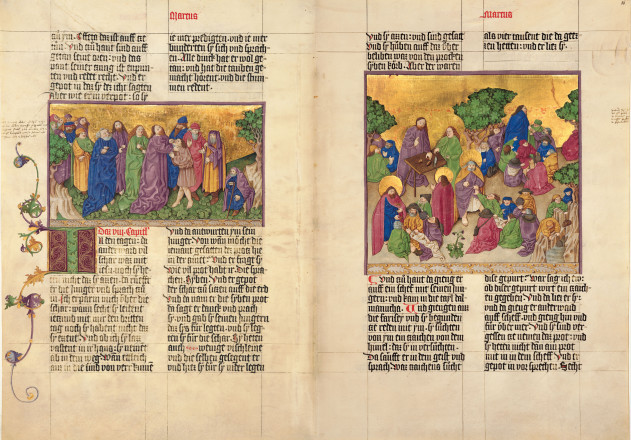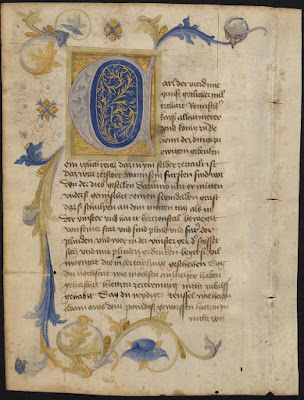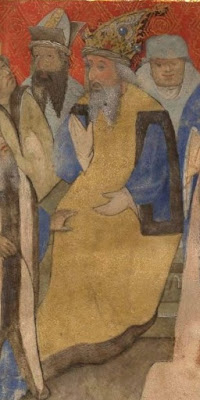 |
| Emperor Sigismund and the Electors, German-language copy of the Golden Bull of Charles IV Stadtarchiv Ulm A Urk. Ve. 1356 Januar 10, fol. 1v |
At an exhibition held last year at Neuburg an der Donau, the chief work in focus was a 15th-century Bible, the Ottheinrich Bible. Regarded as the earliest surviving illustrated manuscript of the New Testament in the German language, it was originally commissioned around 1430 by Ludwig VII, the Bearded, Duke of Bavaria-Ingolstadt. It was illuminated by three Regensburg painters, but its decoration remained unfinished - only to be completed by the artist Mathis Gerung in 1530–31. The manuscript was later split up into eight volumes, and after a rather complicated history, now all of its parts are at the Bavarian State Library in Munich - on their website, you can browse the digitized volumes of the Bible.
The exhibition, titled Kunst und Glaube, contained lots of interesting objects, as far as I can tell based on the catalogue. I was most interested in objects dating from the period of Ludwig VII of Bavaria (Duke of Bavaria-Ingolstadt between 1413-1447), a contemporary of King and Emperor Sigismund, and a noted patron of the arts. Perhaps the most well-known of his commissions is the small-scale model of this tombstone, made by Hans Multscher around 1435 (Munich, Bayerisches Nationalmuseum). This tomb was never executed in full size. The Ottheinrich Bible was also one of his important commissions, which remained unfinished.
 |
| Double page from the Ottheinrich Bible, c. 1430 (vol. 2.) |
One of the objects in this section was a fragmentary manuscript of the Golden Bull of Charles IV, which was illuminated by the workshop of the Ottheinrich Bible (the so-calle Matthäusmaler). The manuscript was executed in Regensburg, and its surviving fragment is kept at the Town Archives of Ulm (See catalogue record). The fragment was identified as dating from this period by professor Robert Suckale, who provided a study about the Ottheinrich Bible for the catalogue (and also contributed to the catalogue entry in question, cat. no. 5.18). The fragment consists of only three leafs, containing a German translation of the Golden Bull issued in 1356. On the verso of the first folio, a group portrait of the Holy Roman Emperor with the Electors is depicted (see above). As Sigismund was also the King of Bohemia from 1419, only six Electors are depicted around the Emperor. On fol. 2r, the fragment also includes the full page depiction of coat of arms of a certain Hans Kastenmayer of Straubing - an image very similar to those included on armorial letters issued by the imperial chancery at that time, and the fragment also contains a nice initial.
 |
| Decorated page of the Ulm fragment |
Based on various art historical and historical considerations, the illumination of the manuscript fragment is dated to 1430, and the identification of Emperor Sigismund is quite secure: as it is pointed out in the catalogue, not only the coat of arms identify the central figure, but also the characteristic features of Sigismund: his log bear and aquiline nose. A comparison is made with the statue of the King of Bohemia, which Hans Multscher made for the Town Hall of Ulm around 1427-1430, to complete the cycle of the Electors there (he also sculpted the image of the Emperor and a figure of the King of Hungary - a depiction which was only included because of the person of Sigismund, who of course also held this title). Several other examples could be cited - as already discussed on this blog, Sigismund was quite frequently depicted in various contexts. This newly identified image, however, is very important, as it is an addition to his contemporary depictions in an actual historical context, made in one of the main centers of the Holy Roman Empire.
 |
| Hans Multscher: Sigismund as King of Bohemia, 1427-1430. Ulm, Town Hall |
Stadtarchiv Ulm A Urk. Ve. 1356 Januar 10
fol. 1v: Emperor and the Electors
Kunst & Glaube. Ottheinrichs Prachtbibel und die Schlosskapelle Neuburg. ed.: Brigitte Langer, Thomas Rainer. Exh. cat. Schloss Neuburg a.d. Donau, Regensburg, 2016.
You can take a peek at the book here.
Read more about the exhibition in the Augsburger Allgemeine (source of the lead image), or in this review by Stephan Hoppe.

Very detailed brieifing of exhibition you took a year ago. Complete information along with pictures. You have written this piece very beautifully
ReplyDelete